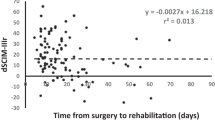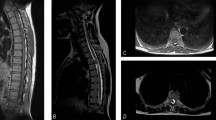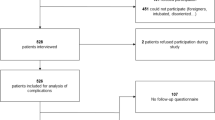Abstract
Study design
Retrospective analysis of clinical routine data.
Objectives
Spinal meningioma is a common type of benign spinal tumor. Surgical removal is the standard therapeutic approach. While surgery is generally associated with excellent outcomes, little is known about the rehabilitation outcome of patients with postoperative deficits. Therefore, we aim to describe the clinical features and rehabilitation outcomes of patients after surgical removal of spinal meningioma.
Setting
Region of Swabia, Bavaria, Germany.
Methods
We conducted a retrospective analysis of patients with spinal meningioma who underwent a rehabilitation program for patients with non-traumatic spinal cord injury at our department over the past five years. In addition to routine data, we focussed on analysing the Barthel Index, SCIM III score, and ASIA impairment scale before and after rehabilitation.
Results
15 patients were included in the analysis. While most of them only had a few restrictions relevant to activities of daily living, some had severely limited walking ability. The predominant clinical feature was incomplete paraplegia with or without neurogenic bladder and bowel affection. The Barthel Index and SCIM III score demonstrated positive changes in the majority of cases, while alterations in the ASIA impairment scale were observed in a minority.
Conclusion
Considering the results of outcome parameters, rehabilitation treatment appears effective for these patients. Nonetheless, further studies with larger patient cohorts are necessary to confirm these findings.
This is a preview of subscription content, access via your institution
Access options
Subscribe to this journal
Receive 1 print issues and online access
We are sorry, but there is no personal subscription option available for your country.
Buy this article
- Purchase on SpringerLink
- Instant access to full article PDF
Prices may be subject to local taxes which are calculated during checkout

Similar content being viewed by others
Data availability
The data that support the findings of this study are available on request from the corresponding author Gdynia HJ. The data are not publicly available due to them containing information that could compromise research participant privacy/consent.
References
Helseth A, Mørk SJ. Primary intraspinal neoplasms in Norway, 1955 to 1986. A population based survey of 467 patients. J Neurosurg. 1989;71:842–5.
Tsuda K, Akutsu H, Yamamoto T, Nakai K, Ishikawa E, Matsumura A. Is Simpson grade I removal necessary in all cases of spinal meningioma? Assessment of postoperative recurrence during long-term follow-up. Neuro Med Chir. (Tokyo). 2014;4:907–13.
Gezen F, Kahraman S, Canakci Z, Bedük A. Review of 36 cases of spinal cord meningioma. Spine. 2000;25:727–31.
Gottfried ON, Gluf W, Quinones-Hinojosa A, Kan P, Schmidt MH. Spinal meningiomas: surgical management and outcome. Neurosurg Focus. 2003;14:e2.
King AT, Sharr MM, Gullan RW, Bartlett JR. Spinal meningiomas: a 20-year review. Br J Neurosurg. 1998;12:521–6.
Klekamp J, Samii M. Surgical results for spinal meningiomas. Surg Neurol. 1999;52:552–62.
Riad H, Knafo S, Segnarbieux F, Lonjon N. Spinal meningiomas: surgical outcome and literature review. Neurochirurgie. 2013;59:30–34.
Noh SH, Kim KH, Shin DA, Park JY, Yi S, Kuh SU, et al. Treatment outcomes of 17 patients with atypical spinal meningioma, including 4 with metastases: a retrospective observational study. Spine. 2019;19:276–84.
Czigléczki G, Németh F, Berényi G, Banczerowski P. Prognostic factors of surgically treated spinal meningeomas and long-term surgical outcomes. Ideggyogy Sz. 2019;30:93–97.
Schick U, Marquardt G, Lorenz R. Recurrence of benign spinal neoplasms. Neurosurg Rev. 2001;24:20–25.
Wu L, Yang T, Deng X, Yang C, Zhao L, Yao N, et al. Spinal extradural en plaque meningiomas: clinical features and long-term outcomes of 12 cases. J Neurosurg Spine. 2014;21:892–8.
Nakamura M, Tsuji O, Fujiyoshi K, Hosogane N, Watanabe K, Tsuji T, et al. Long-term surgical outcomes of spinal meningiomas. Spine (Phila Pa 1976). 2014;37:E617–23.
Côté MP, Murray M, Lemay MA. Rehabilitation strategies after spinal cord injury: inquiry into the mechanisms of success and failure. J Neurotrauma. 2017;34:1841–57.
Lu X, Battistuzzo CR, Zoghi M, Galea MP. Effects of training on upper limb function after cervical spinal cord injury: a systematic review. Clin Rehabil. 2015;29:3–13.
Duan R, Qu M, Yuan Y, Lin M, Liu T, Huang W, et al. Clinical benefit of rehabilitation training in spinal cord injury: a systematic review and meta-analysis. Spine (Phila Pa 1976). 2021;46:E398–E410.
Lübke N, Meinck M, von Renteln-Kruse W. The Barthel Index in geriatrics. A context analysis for the Hamburg Classification Manual. Z Gerontol Geriatr. 2004;37:316–26.
Itzkovich M, Biering-Sorensen IG, Weeks C, Laramee MT, Craven BC, Tonack M, et al. The Spinal Cord Independence Measure (SCIM) version III: reliability and validity in multi-center international study. Disabil Rehabil. 2007;29:1926–33.
Roberts TT, Leonard GR, Cepela DJ. Classifications in brief: American Spinal Injury Association (ASIA) Impairment Scale. Clin Orthop Relat Res. 2017;475:1499–504.
Cohen J. Statistical Power Analysis for the Behavioral Sciences. 2nd Edition, Taylor and Francis, New York, 1988.
DiGiorgio AM, Virk MS, Mummaneni PV. Spinal meningiomas. Handb Clin Neurol. 2020;170:251–6.
Post MW, Dallmeijer AJ, Angenot EL, van Asbeck FW, van der Woude LH. Duration and functional outcome of spinal cord injury rehabilitation in the Netherlands. J Rehabil Res Dev. 2005;42(3 Suppl 1):75–85.
Anderson K, Aito S, Atkins M, Biering-Sørensen F, Charlifue S, Curt A, et al. Functional Recovery Outcome Measures Work Group. Functional recovery measures for spinal cord injury: an evidence-based review for clinical practice and research. J Spinal Cord Med. 2008;31:133–44.
Catz A, Itzkovich M, Rozenblum R, Elkayam K, Kfir A, Tesio L, et al. A multi-center international study on the spinal cord independence measure, version IV: Rasch psychometric validation. J Spinal Cord Med. 2024;47:681–91.
Author information
Authors and Affiliations
Contributions
HJG conceived the presented project and wrote the manuscript with contributions of NG and AG. HJG, PS, AG, KW collected the data. IH performed the statistical analysis. HJG, NG, PS, AG, KW and IH evaluated the data, drew conclusions and contributed to the final version of the manuscript. All authors approved the final version of the manuscript.
Corresponding author
Ethics declarations
Competing interests
The authors declare no competing interests.
Ethical statement
The responsible ethics committee has confirmed that ethical approval is not required according to local laws and regulations (ethics committee ‘Bayerischen Landesärztekammer, Germany’, No. 240063).
Additional information
Publisher’s note Springer Nature remains neutral with regard to jurisdictional claims in published maps and institutional affiliations.
Rights and permissions
Springer Nature or its licensor (e.g. a society or other partner) holds exclusive rights to this article under a publishing agreement with the author(s) or other rightsholder(s); author self-archiving of the accepted manuscript version of this article is solely governed by the terms of such publishing agreement and applicable law.
About this article
Cite this article
Gdynia, HJ., Schneiderat, P., Gratzer, A. et al. Clinical features and rehabilitation outcome after surgical treatment of spinal meningioma. Spinal Cord Ser Cases 10, 75 (2024). https://doi.org/10.1038/s41394-024-00688-5
Received:
Revised:
Accepted:
Published:
DOI: https://doi.org/10.1038/s41394-024-00688-5



